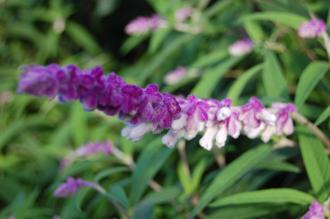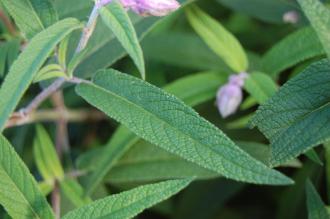
Salvia leucantha (03/11/2013, Kew Gardens, London)
Position: Full sun to partial shade
Flowering period: Late summer to autumn
Soil: Moist, well drained
Eventual Height: 1.2m
Eventual Spread: 1.5m
Hardiness: 7a, 7b, 8a, 8b, 9a, 9b, 10a, 10b, 11 (the above ground part of this shrub will die at the colder end of its hardiness range)
Family: Lamiaceae
Salvia leucantha is an evergreen shrub with an erect, bushy habit. Its silvery, dark green leaves are lanceolate with finely serrulate margins, up to 20cm long and 4cm broad. Its purple and white flowers appear as a terminal spike which is up to 30cm long. Its roots may sucker which aids its spread.

Salvia leucantha Flower (03/11/2013, Kew Gardens, London)
Salvia leucantha, commonly known as Mexican Bush Sage, is native to east and central Mexico. In its native habitat it grows in conifer forests.
The etymological root of the binomial name Salvia is derived from the Latin salvare, meaning to ‘save’ or ‘heal’, in reference to its historical use as a medicinal plant. Leucantha is derived from the Greek leukos meaning ‘white’ and anthos
The landscape architect may find Salvia leucantha useful as a late flowering shrub with attractive foliage. Once established this plant will tolerate some drought.
Ecologically, Salvia leucantha flowers are attractive to pollinating insects and nectar loving birds.
The Royal Horticultural Society has given Salvia leucantha their prestigious Award of Garden Merit in 1993.

Salvia leucantha Leaf (03/11/2013, Kew Gardens, London)
Salvia leucantha prefers moist, loamy, well-drained soils. It tolerates most pH of soil. It dislikes excessive moisture during the winter months.
Salvia leucantha requires little maintenance. If required, pruning should be carried out in mid spring before growth begins.

